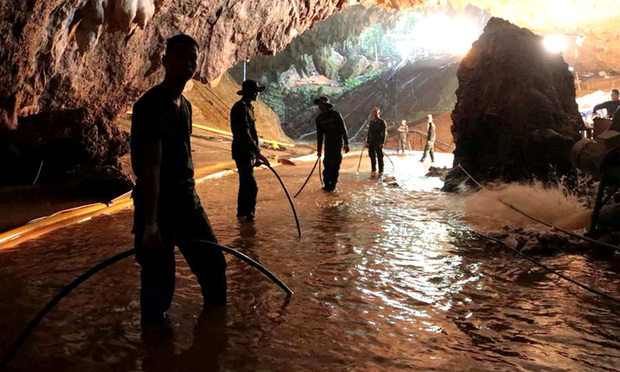Cave-Diving Atlanta Lawyer on Thai Rescue: 'Miraculous'
To the dangers present in every submerged cave, the Tham Luang rescue added far more.
July 11, 2018 at 04:54 PM
5 minute read
 Thai rescue teams arrange water pumping system at the entrance to a flooded cave complex where 12 boys and their soccer coach were trapped since June 23 in Mae Sai, Chiang Rai province, northern Thailand. Photo courtesy of Royal Thai Navy Like most of the world, I watched with hope and fascination as selfless Thai military divers and expert volunteer cave divers from around the world saved 12 boys and their soccer coach from certain horrific death 2.5 miles inside a flooded Thailand cave. The Daily Report's Jonathan Ringel asked me, an avid cave diver, if I'd offer some observations on the rescue. First, this rescue was every bit as sensational and miraculous as the media have portrayed it. The Tham Luang cave passage that trapped these boys when it flooded comprised nearly two miles of dry cave interrupted by several underwater passages, or “sumps.” The rescuers had to dive through each of these, including with children who can't swim. Most of my cave diving experience has been in northern Florida, which boasts some of the most challenging cave diving in the world. Under the best of circumstances, cave diving poses significant risks far beyond recreational scuba diving, including light failure, lost guideline, disorientation, drysuit failure (wetsuits are rarely suitable for cave diving because of the cold water and long durations), hypothermia and loss of breathing gas. To these dangers, present in every submerged cave, the Tham Luang rescue added far more.
Thai rescue teams arrange water pumping system at the entrance to a flooded cave complex where 12 boys and their soccer coach were trapped since June 23 in Mae Sai, Chiang Rai province, northern Thailand. Photo courtesy of Royal Thai Navy Like most of the world, I watched with hope and fascination as selfless Thai military divers and expert volunteer cave divers from around the world saved 12 boys and their soccer coach from certain horrific death 2.5 miles inside a flooded Thailand cave. The Daily Report's Jonathan Ringel asked me, an avid cave diver, if I'd offer some observations on the rescue. First, this rescue was every bit as sensational and miraculous as the media have portrayed it. The Tham Luang cave passage that trapped these boys when it flooded comprised nearly two miles of dry cave interrupted by several underwater passages, or “sumps.” The rescuers had to dive through each of these, including with children who can't swim. Most of my cave diving experience has been in northern Florida, which boasts some of the most challenging cave diving in the world. Under the best of circumstances, cave diving poses significant risks far beyond recreational scuba diving, including light failure, lost guideline, disorientation, drysuit failure (wetsuits are rarely suitable for cave diving because of the cold water and long durations), hypothermia and loss of breathing gas. To these dangers, present in every submerged cave, the Tham Luang rescue added far more. Restriction
To reach and extract the boys, divers had to squeeze though a narrow passage, or “restriction.” Many caves have restrictions. But few cave divers will attempt a restriction so narrow that it requires a diver to completely remove his or her breathing gas tanks and push them through with hoses trailing behind, as the rescuers had to do with boys' air supply. (Some cave divers “sidemount” their tanks under their arms to reduce bulk on their backs to access cave passages designated “sidemount only.”)Variable Water Flow
The flow in some caves, like Twin Cave in Jackson County, Florida, is relatively low. In others, like the cave under Weeki Wachee Springs (of mermaid show fame), the flow is so strong that authorities closed it to nearly all cave diving in 2001. Because of seasonal monsoon rains, Tham Luang's flow varies treacherously between these two extremes.Horizontal Penetration
The rescuers' challenge was not the depth of the water; a recreational scuba diver on holiday in the Caribbean would routinely dive to depths greater than this cave's. But a recreational diver can surface at any time, making an out-of-air death extremely unlikely as long as the diver follows his or her training. In the underwater portion of the Tham Luang rescue, the divers were over half a mile from the normally oxygenated air on the exit side of the sump, and then as much as two miles from ambient light in the dry sections. By comparison, many highly experienced cave divers have never ventured more than a half-mile from a cave entrance.Visibility
In Florida caves, the water is usually gin-clear. That is, unless a careless diver stirs up silt, which can instantly reduce the visibility to roughly that of chocolate milk. In Tham Luang, however, the sudden and variable flow of rainwater could plunge the visibility of the entire underwater passage to zero through no fault of the divers. In these blackout conditions, the rescuers had to maintain constant physical contact with their guideline and exit the half-mile sump entirely by feel, all while also holding the boy they were rescuing. The greatest risk to these boys—who don't know how to swim, let alone engage in the most dangerous form of scuba diving—was panic during their underwater extraction. Cave divers' training and years of experience reduce the risk of panic in these hostile environments. A panicked diver in any environment is a great risk to himself and his rescuer. A panicked diver will frequently spit out his mouthpiece and tear out his rescuer's. In a cave, panic almost always equals drowning. Robert Highsmith. Aware of this risk, the rescuers wisely used full-face masks on the boys. Unlike traditional gear that requires a diver to hold a breathing gas regulator in his or her mouth and keep a dive mask with a single strap on his or her face, full-face masks securely seal the wearer's face from forehead to chin. They are much harder to dislodge, can enable voice communication among divers, and will continue to supply respirable gas even to an unconscious or thrashing diver. The Georgia Aquarium volunteer dive team, on which I served for four years, uses full-face masks for certain maintenance operations because of this additional margin of safety. As a final observation, most media have repeatedly referred to the divers' “oxygen tanks.” It would greatly surprise me to learn that any of these rescue dives used pure oxygen. For cave dives in water depths less than 100 feet, plain old compressed air—which is only 21 percent oxygen—is usually the breathing gas of choice. Robert Highsmith , a partner in Holland & Knight, is certified by the International Association of Nitrox and Technical Divers to dive to depths of 330 feet using helium-based hypoxic breathing gas, and full-cave certified in the use of the Inspiration Vision closed-circuit rebreather by Technical Diving International.
Robert Highsmith. Aware of this risk, the rescuers wisely used full-face masks on the boys. Unlike traditional gear that requires a diver to hold a breathing gas regulator in his or her mouth and keep a dive mask with a single strap on his or her face, full-face masks securely seal the wearer's face from forehead to chin. They are much harder to dislodge, can enable voice communication among divers, and will continue to supply respirable gas even to an unconscious or thrashing diver. The Georgia Aquarium volunteer dive team, on which I served for four years, uses full-face masks for certain maintenance operations because of this additional margin of safety. As a final observation, most media have repeatedly referred to the divers' “oxygen tanks.” It would greatly surprise me to learn that any of these rescue dives used pure oxygen. For cave dives in water depths less than 100 feet, plain old compressed air—which is only 21 percent oxygen—is usually the breathing gas of choice. Robert Highsmith , a partner in Holland & Knight, is certified by the International Association of Nitrox and Technical Divers to dive to depths of 330 feet using helium-based hypoxic breathing gas, and full-cave certified in the use of the Inspiration Vision closed-circuit rebreather by Technical Diving International.This content has been archived. It is available through our partners, LexisNexis® and Bloomberg Law.
To view this content, please continue to their sites.
Not a Lexis Subscriber?
Subscribe Now
Not a Bloomberg Law Subscriber?
Subscribe Now
NOT FOR REPRINT
© 2025 ALM Global, LLC, All Rights Reserved. Request academic re-use from www.copyright.com. All other uses, submit a request to [email protected]. For more information visit Asset & Logo Licensing.
You Might Like
View All

CFPB Proposes Rule to Regulate Data Brokers Selling Sensitive Information
5 minute read
Trending Stories
- 1Big Law Firms Sheppard Mullin, Morgan Lewis and Baker Botts Add Partners in Houston
- 2Lack of Jurisdiction Dooms Child Sex Abuse Claim Against Archdiocese of Philadelphia, says NJ Supreme Court
- 3DC Lawsuits Seek to Prevent Mass Firings and Public Naming of FBI Agents
- 4Growth of California Firms Exceeded Expectations, Survey of Managing Partners Says
- 5Blank Rome Adds Life Sciences Trio From Reed Smith
Who Got The Work
J. Brugh Lower of Gibbons has entered an appearance for industrial equipment supplier Devco Corporation in a pending trademark infringement lawsuit. The suit, accusing the defendant of selling knock-off Graco products, was filed Dec. 18 in New Jersey District Court by Rivkin Radler on behalf of Graco Inc. and Graco Minnesota. The case, assigned to U.S. District Judge Zahid N. Quraishi, is 3:24-cv-11294, Graco Inc. et al v. Devco Corporation.
Who Got The Work
Rebecca Maller-Stein and Kent A. Yalowitz of Arnold & Porter Kaye Scholer have entered their appearances for Hanaco Venture Capital and its executives, Lior Prosor and David Frankel, in a pending securities lawsuit. The action, filed on Dec. 24 in New York Southern District Court by Zell, Aron & Co. on behalf of Goldeneye Advisors, accuses the defendants of negligently and fraudulently managing the plaintiff's $1 million investment. The case, assigned to U.S. District Judge Vernon S. Broderick, is 1:24-cv-09918, Goldeneye Advisors, LLC v. Hanaco Venture Capital, Ltd. et al.
Who Got The Work
Attorneys from A&O Shearman has stepped in as defense counsel for Toronto-Dominion Bank and other defendants in a pending securities class action. The suit, filed Dec. 11 in New York Southern District Court by Bleichmar Fonti & Auld, accuses the defendants of concealing the bank's 'pervasive' deficiencies in regards to its compliance with the Bank Secrecy Act and the quality of its anti-money laundering controls. The case, assigned to U.S. District Judge Arun Subramanian, is 1:24-cv-09445, Gonzalez v. The Toronto-Dominion Bank et al.
Who Got The Work
Crown Castle International, a Pennsylvania company providing shared communications infrastructure, has turned to Luke D. Wolf of Gordon Rees Scully Mansukhani to fend off a pending breach-of-contract lawsuit. The court action, filed Nov. 25 in Michigan Eastern District Court by Hooper Hathaway PC on behalf of The Town Residences LLC, accuses Crown Castle of failing to transfer approximately $30,000 in utility payments from T-Mobile in breach of a roof-top lease and assignment agreement. The case, assigned to U.S. District Judge Susan K. Declercq, is 2:24-cv-13131, The Town Residences LLC v. T-Mobile US, Inc. et al.
Who Got The Work
Wilfred P. Coronato and Daniel M. Schwartz of McCarter & English have stepped in as defense counsel to Electrolux Home Products Inc. in a pending product liability lawsuit. The court action, filed Nov. 26 in New York Eastern District Court by Poulos Lopiccolo PC and Nagel Rice LLP on behalf of David Stern, alleges that the defendant's refrigerators’ drawers and shelving repeatedly break and fall apart within months after purchase. The case, assigned to U.S. District Judge Joan M. Azrack, is 2:24-cv-08204, Stern v. Electrolux Home Products, Inc.
Featured Firms
Law Offices of Gary Martin Hays & Associates, P.C.
(470) 294-1674
Law Offices of Mark E. Salomone
(857) 444-6468
Smith & Hassler
(713) 739-1250







